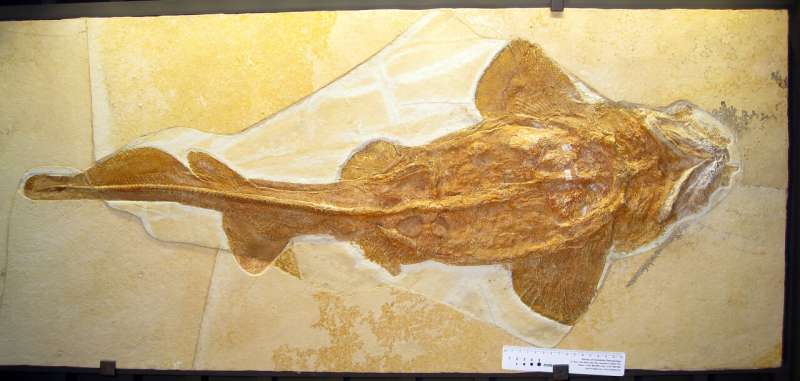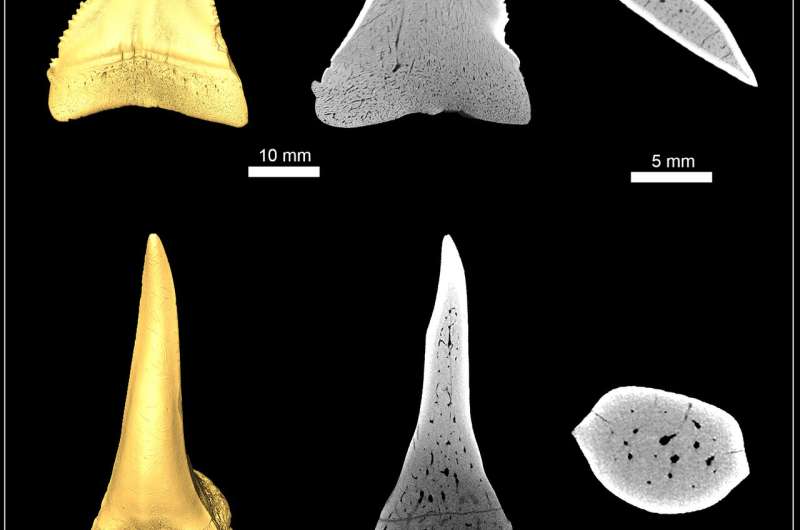Tracking evolution through teeth: The small-fry ancestor of the great white shark

Mackerel sharks (Lamniformes) are a group consisting of some of the most iconic sharks we know, including the mako shark (the fastest shark in the world), the infamous great white shark, and Megalodon, the biggest predatory shark that has ever roamed the world's oceans. An international team of researchers around Patrick L. Jambura from the University of Vienna found a unique feature in the teeth of these apex predators, which allowed them to trace back the origin of this group to a small benthic shark from the Middle Jurassic (165 mya). Their study was recently published in the journal Scientific Reports.
Similar to humans, shark teeth are composed of two mineralized structures: a hard shell of hypermineralized tissue (in humans enamel, in sharks enameloid) and a dentine core. Depending on the structure of the dentine we distinguish between two different types: orthodentine and osteodentine.
Orthodentine has a very compact appearance and is similar to the dentine we can find in human teeth. In shark teeth, orthodentine is confined to the tooth crown. In contrast, the other dentine type is spongious in appearance and resembles real bone and therefore is called osteodentine. It can be found in the root, anchoring the tooth to the jaw and in some species also in the tooth crown where it supports the orthodentine.
Using high resolution CT scans, Patrick L. Jambura and his colleagues examined the tooth composition of the great white shark and its relatives and found a peculiar condition of the teeth of members of this group: the osteodentine of the roots intrudes into the crown and replaces the orthodentine there completely, making it the only type of dentine being present. This condition is not known from any other shark, which all possess orthodentine to some degree and thus it is confined to members of this group.

Another species that was examined was the fossil shark Palaeocarcharias stromeri, which is well-represented by complete skeletons from the famous 150 million year old Solnhofen Plattenkalks of South Germany. The oldest find of this species is from the Middle Jurassic (165 million years ago) and it didn't have much in common with today's mackerel sharks. Palaeocarcharias was a small sluggish benthic shark, not exceeding lengths of more than a metre, that seemingly hunted small fish in shallow waters. To this day, its affiliation has been a riddle to scientists, since its body shape resembles a carpet shark, while its fang-like teeth are similar to mackerel sharks. The examination of the tooth microstructure yielded the presence of the same unique tooth composition that is found only in great white sharks and their relatives. The shared tooth histology is a strong indicator that this small inconspicuous shark gave rise to one of the most iconic shark lineages that includes giants like the extinct Megalodon or the living great white shark.
"Orthodentine is known for almost all vertebrates—from fish to mammals, including all modern sharks, except for the mackerel sharks. The discovery of this unique tooth structure in the fossil shark Palaeocarcharias strongly indicates that we found the oldest known ancestor of the great white shark and shows that even this charismatic giant shark started on a shoestring," says Patrick L. Jambura.
More information: Patrick L. Jambura et al. Micro-computed tomography imaging reveals the development of a unique tooth mineralization pattern in mackerel sharks (Chondrichthyes; Lamniformes) in deep time, Scientific Reports (2019). DOI: 10.1038/s41598-019-46081-3
Journal information: Scientific Reports
Provided by University of Vienna

















